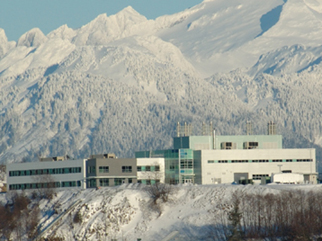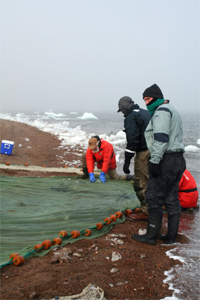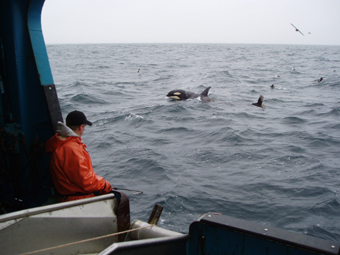

Auke Bay Laboratories
 |
|
Ted Stevens Marine Research Institute (Photo by John Hudson).
|
The Alaska Fisheries Science Center's Auke Bay Laboratories (ABL) conducts scientific research throughout Alaska on fish stocks, fish habitats, and the chemistry of marine environments. Information from this research is widely used by commercial interests such as fishing industries, and governmental agencies involved in managing natural resources. The headquarters of ABL is the Ted Stevens Marine Research Institute (pictured to the right), an office and laboratory building located at Lena Point, north of Juneau, Alaska. The ABL headquarters serves as the focal point for four other ABL facilities. Three ABL facilities are located in the City and Borough of Juneau at Auke Bay, Auke Creek, and downtown Juneau, and one is located at Little Port Walter, on Baranov Island, southeast of Sitka. Auke Bay Marine Station includes fresh and salt water laboratories, offices, and dive and docking facilities. Auke Creek Research Station is a permanent fish weir and hatchery owned by NOAA that is jointly operated with the University of Alaska Fairbanks School of Fisheries and Ocean Sciences and the Alaska Department of Fish and Game. The Juneau Subport Dock and Warehouse has berthing and crane facilities for ocean going vessels, warm dry storage, office space and the Alaska Department of Fish and Game boat repair and storage facility. Little Port Walter Marine Station has fixed and floating docks, office space, dry storage, bunkhouse and kitchen, and fish weir and hatchery.
 |
|
Habitat and Marine Chemistry.
Beaufort Sea sampling of coastal fish populations near Barrow, Alaska, August 2006. |
Marine survey data from ABL research on commercially marketable
species such as rockfish, sablefish, and salmon, and on non-marketable and/or
protected species such as eel grass, plankton, Steller sea lions, and harbor seals are
packaged in information products essential to fishing industries, state and
federal regulators, and international treaty bodies. Groups involved in managing
human activities in coastal environments frequently base their actions on ABL's
knowledge of the quantities and qualities of fish habitats in the affected
areas. ABL's capabilities in environmental chemistry research contribute
to greater understanding of the fate and effects of pollutants in marine ecosystems
and the structure and functioning of marine food webs. ABL is organized into
the four major research programs: Marine
Salmon Interactions, Marine Ecology and
Stock Assessment, Ocean
Carrying Capacity, and
Habitat Assessment and Marine Chemistry (Organizational Chart).
 |
|
Marine Ecology and Stock Assessment.
ABL sablefish longline survey on Alaskan Leader, 2004. |
For more information on ABL please contact (907) 789-6000. The ABL Director, Phil Mundy, can be reached at Phil.Mundy@noaa.gov or (907) 789-6001, and the ABL Deputy Director, Steve Ignell, at Steve.Ignell@noaa.gov or (907) 789-6029. For E-mail and telephone contact information on other ABL employees, please use the NOAA People Locator.
News and Research Highlights
 |
|
New! Juneau Humpback Whale Catalog
August 11, 2008
A resource for humpback whale fluke identification including 99 fluke photographs as well as general inforrmation about the humpbacks that frequent the Juneau area. More> |
| |
Featured Research, Publications, Posters, Reports, and Activities
- Seasonal
Variation in Energy Allocation Strategies of Walleye Pollock by
Ron Heintz
- Sablefish,
Anoplopoma fimbria, Populations on Gulf of Alaska Seamounts by
Nancy Maloney
-
Auke Bay Laboratories Research Reports and Activities
- Morphology and molecular phylogeny of Aureophycus aleuticus gen. et sp. nov (Laminariales, Phaeophyceae) from the Aleutian Islands.
KAWAI, H., T. HANYUDA, M. LINDEBERG, and S. C. LINDSTROM.
2008. Morphology and molecular phylogeny of Aureophycus aleuticus gen. et sp. nov (Laminariales, Phaeophyceae) from the Aleutian Islands. J. Phycol. 44:1013-1021.
- Community level effects of Nereocystis luetkeana in southeastern Alaska.
SIDDON, E. C., C. E. SIDDON, and M. S. STEKOLL.
2008. Community level effects of Nereocystis luetkeana in southeastern Alaska. J. Exp. Mar. Biol. Ecol. 361:8-15.
- Unanticipated departures from breeding designs can be detected using microsatellite DNA parentage analyses.
GRAY, A. K., J. J. JOYCE, and A. C. WERTHEIMER.
2008. Unanticipated departures from breeding designs can be detected using microsatellite DNA parentage analyses. Aquaculture 280:71-75.
- Fish assemblages in shallow, nearshore waters of the Bering Sea.
THEDINGA, J. F., S. W. JOHNSON, A. D. NEFF, and M. R. LINDEBERG.
2008. Fish assemblages in shallow, nearshore waters of the Bering Sea. Trans. Am. Fish. Soc. 137:1157-1164.
- Juvenile Quillback Rockfish Habitat Utilization
By: PATRICK MALECHA
Conference: Western Groundfish Conference (15th), Santa Cruz, CA., Feb 2008
(2008 poster, .pdf, 152KB) Online.
- Temporal Stability of Fatty Acids in Herring Hearts
By: JACEK MASELKO, RON HEINTZ, TED OTIS
Conference: Alaska Marine Science Symposium, Anchorage, AK, Jan 2008
(2008 poster, .pdf, 332KB) Online.
See the publications and posters databases for additional listings.
To view and print these documents, you must install
Adobe Acrobat Reader
freeware. Adobe also offers
free tools
for the visually disabled.
|